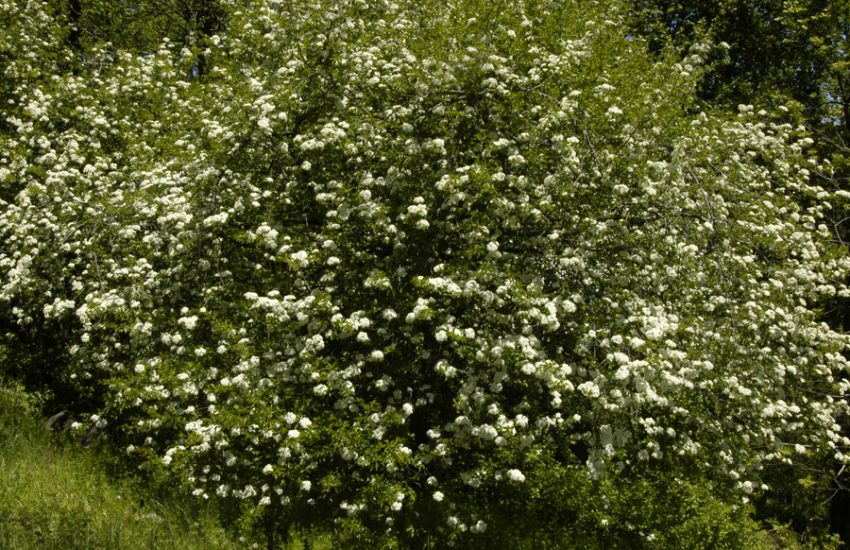9 Flowering Vines to Grow in Idaho
Flowering vines not only serve to improve the aesthetic beauty of the garden but also act to soften hard edges, add privacy and benefit the environment as a whole. Idaho has a variety of flowering vines that thrive in its hardy zones and have been trained to grow on trellises, gazebos, and arbors. Moreover, flowering vines are a good choice for your garden because they generally require low maintenance once they have been established in the soil.
Flowering vines are your go-to choice if you want to add a vertical dimension to your landscape or garden. They attract butterflies, and hummingbirds, among other native pollinators. When choosing listed perennial vines, ensure they are listed as hardy to be compatible with your planting zone. Deciding where and how to position perennial vines can prove to be a daunting task and an important consideration made by the gardener. For a more enhanced visual appearance, you can opt to mix different flowering plants or plant them side by side to achieve a striking combination.
Perennial vines are capable of staying in your garden for years and only get larger and fuller as time goes by. It is possible to train some stunning perennial flowering vines over trellises and doorways or even make them dangle from pots and up trees to ensure your surroundings are beautiful.
The following are some of the best flowering vines to grow in Idaho:
1. Clematis
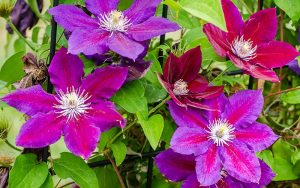
Clematis is one of the most planted and popular perennials. Its success depends on the planting site’s preparation level, the identified location, the pruning administered, and the identified method of planting. Roughly, it consists of 300 species of profusely blooming, woody-stemmed plants. Apart from the climbing and flowering Clematis plants, species also appear to be short and bushy. They produce large, petaled, delicate bell-shaped and star-shaped flowers with their colors ranging from yellow, white deep purple, and deep red to periwinkle.
They are annual flowering and climbing vines, require minimal to no care once established into the soil but may need assistance in moisture retention during the hotter months. They have vanilla, sweet honey, or almond fragrance and potentially do well in both partial to full shade. Some of the Clematis varieties to choose from include:
● Avalanche – It consists of a riot of white blooms during the early spring, with its foliage having a lace-like appearance.
● Wisley Cream – from November to January, the Wisley Cream has a creamy bell-shaped bloom, and its glossy green leaves turn to a dappled bronze as the temperatures cool.
● Clematis fasciculiflora is another specie of rare and evergreen cultivar with its foliage striated with silver veinings transitioning from purple to rust to green hues. During the early spring, this specie has bell-shaped blooms.
Before planting, ensure the soil is adorned with enough organic matter, is well drained, and the newly planted ones pruned to 12 inches during spring after the planting season. This is done so the plant can achieve a fuller and denser appearance. Also, you apply 2-4 inches of mulch layers around the plant to help maintain cool soil temperatures.
2. Chocolate Vine
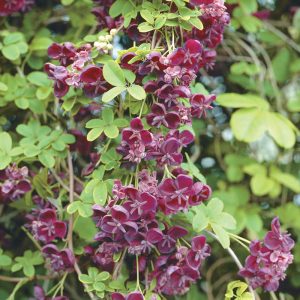
The chocolate vine blooms to produce spicy-scented clusters of cup-shaped flowers that appear brownish purple and hang like pendants. Its semi-evergreen foliage remains attractive with lush after the fading of the flowers, and its oblong leaves are usually in a group of five leaflets. They have an aroma similar to chocolate with a slightly malted scent and are a great alternative for farmers looking for climbing plants that are invasive. If kept under the right conditions, the chocolate vine grows rapidly; hence frequent pruning is required to help maintain it in shape.
Due to their rapid growth, these flowering vines can go up to 50 feet by twinning on a support structure, and more attention needs to be paid to training them to climb well using the adhesive outdoor plant clips. The dangling flowers of the chocolate vine emerge during the spring and boast three petals which are sometimes followed by eggplant-resembling fruits during the late summer. During harvesting, the fruits resemble the kiwi, are edible but not palatable and consist of tiny black seeds engraved in their pulp. If you are growing it for harvesting purposes, ensure you plant at least two of the vines to increase fruiting and pollination chances.
Apart from its fruiting value, some gardeners choose to grow the chocolate vine as a ground cover to disguise tree trumps, rock piles, and manhole covers which are often considered eyesores. However, the chocolate vine’s delicate flowers may get lost in the ground when planted for ground-covering purposes.
3. Climbing Hydrangea
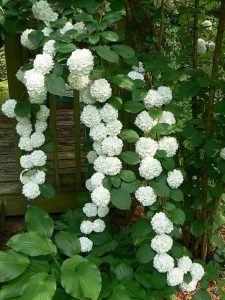
These perennial plants take up to three years to achieve their full establishment, while some may go up o five years depending on the type of climate they have been exposed to. Potentially, they can grow as high as 80 feet, provided they get access to a wall, a large tree, or a fence to cling on and help provide support. They require their gardeners to have a high level of patience and are definitely worth the wait because of their delightful lush flowers. If you are looking to attract pollinators, the climbing hydrangea is your go-to plant for your backyard habitat.
The plant can preferably bloom under partial or full sun, and its branches consist of suckers that allow for the scaling of structures without necessarily needing to use a trellis. While planting, ensure you settle on a favorable spot because all the parts of the climbing hydrangea are toxic to horses, cats, and dogs. Once they achieve full growth, these vines can be heavy hence the importance of ensuring that their supporting structure is strong enough to withstand the weight.
Purple Passionflower
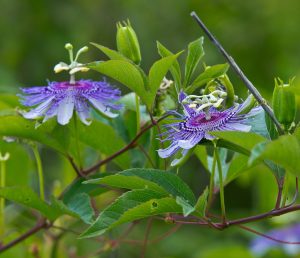
Also known as Maypop, the purple passionflower is a semi-woody vine characterized by large serrated leaves and exotic-looking flowers. Despite it being characterized by a tropical appearance, purple passionflower is surprisingly tough, and butterflies and other pollinators are immensely attracted to their fragrant striking flowers. In addition, it has orange-yellow edible fruits referred to as Maypops due to the sound they produce upon being stepped on and are a source of animal nutrition. Cultivars are available in many color varieties and can grow up to 20 feet tall, especially in cooler climates.
The foliage can provide year-round interest in the hardiness zones while fruiting from September to November and flowering from June to July. However, you can control the plant from having too much foliage and increase the fruit and flower growth by growing it in containers, restricting the root suckers from spreading.
4. Climbing Roses
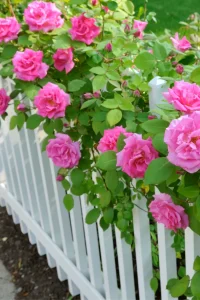
Nothing is more beautiful and delightful than a fence draped in all manner of colorful flowers. Climbing roses constitute large rose shrubs with long stems trained to grow up a supporting structure such as a trellis because they cannot grow independently. As far as roses are concerned, they are fairly easy to grow and maintain, provided it is done under the right conditions and climate. While looking for the right climbing rose to incorporate into your property, ensure you seek advice from a trusted and local professional nursery that will provide adequate guidance on the care and maintenance routine these perennial plants require.
Regarding propagation, climbing roses chose to go with transplanting live and bare root specimens through cuttings, not forgetting the layering method. If you choose to go with transplanting, ensure you have done a little pruning to help the plant achieve its full potential. Climbers need a lot of room to grow; hence, it is important to set enough space for them to avoid monthly pruning.
5. Hardy Kiwi Vine
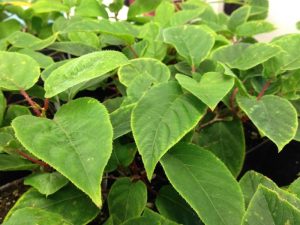
Hardy kiwi vine is particularly grown because of its distinctive foliage and is a cold-hardy relative of the supermarket of kiwis producing plant. Depending on the available variety, the cold-tolerant perennial is grown in USDA zones 3 through 9. Its productions consist of a small edible fruit almost the same size as a large grape and are eaten whole without needing any peeling. The two species called hardy kiwi are:
● Actinidia kolomikta – It has variegated foliage
● Actinidia arguta – Its powers are less vigorous
Although it has small flowers, its fragrance is similar to the valley’s lilies, and the plant can adapt anywhere provided adequate sunlight, and proper care is administered. If you choose to grow the plant for shade, fruit, or foliage, ensure you provide a support system like a fence or pergola for the best results.
6. Mandevilla
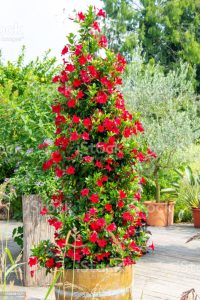
In recent times, Mandevilla has maintained the bar as the most common perennial used on patios, and its brightly colored petals give any landscape a tropical flair. It belongs to the tropical and subtropical flowering vines genus, and its flowers consist of relatively large five fragrant petals and glossy green foliage. As fast-growing vines, these perennials require lots of water to maintain their health and ensure it continues to bloom. Moreover, it must be given a sturdy support structure for good and uniform growth.
Mandevilla needs to be planted on sandy, well-drained with an abundance of organic material and germinates well in full sun, although it can also tolerate partial sun. You can also prune your Mandevilla by pinching to make the plant bushier and fuller. Mandevilla plant is also one of a kind because it is frost-tender and bringing your container-Mandevilla plants into the house during winter ensures they remain healthy and desirable.
7. Moonflower
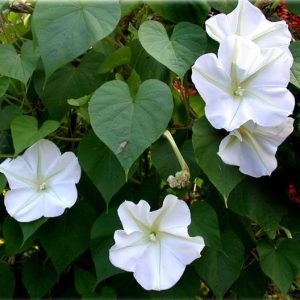
Moonflower flowering vines require little maintenance and are super easy to manage, provided they receive regular feeding and watering. Moreover, they are rarely attacked by pests and diseases and blooms at night to release a sweet fragrance into the air. Then, as the night fades away and morning approaches, their petals close for the day, waiting yet for another evening, and the circle continues. They can grow up to 15 feet in height and are a good mechanism to cover the ground if you decide to grow them as ground covers.
However, the Moonflower has a climbing habit, and it is recommended to provide them with a support structure or trellis for better upright growth. You can ideally have them planted next to the bedroom window or near the deck to enjoy their sweet fragrance every time they open up.
You can deadhead the plant by removing the spent flowers to avoid dropping off the seeds that can potentially germinate into more vines and reseeding your garden.
Deadheading also ensures that the vines have room for further blooming.
8. Star Jasmine
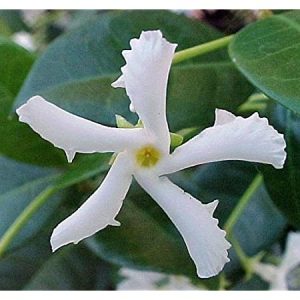
Also known as the Confederate jasmine, this vine produces white blossoms that are highly fragrant and serves well both as a wall decoration and a ground cover plant. It’s a twining flowering vine with dark green leaves, which are not only long but also oval, and has to be provided with a support system in case it is grown as a wall decoration. Although most gardeners grow it as an annual plant, it can also be grown overwintered indoors and inside containers in cooler climates.
It can reach a height of 6 feet in its maturity stages, and you can achieve an even height by pruning the upward-reaching shoots. Star jasmine blooms best in full sun, is comfortable in various soils, and can sometimes do well in partial while also tolerating full shade.
9. Bleeding Heart Vine
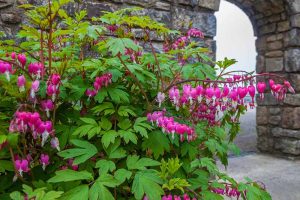
It is an evergreen twinning vine that is fast-growing, tender, and possesses climbing vines resembling the herbaceous perennial bleeding heart. This tropical plant comprises massive clusters of color-showing flowers, has glossy, oval dark green leaves, and is best planted during the spring while it flowers in the summer. If given a support structure, the flowering vine can grow up to 15 feet, and its vines depend on consistently moist soil and can spread up to five feet. For maximum growth, ensure you administer enough fertilizer during the growing season.
When grown outdoors, ensure they are at the base of a clinging object or inside a container, and the most blooms are produced when it is kept under full light. Being thirsty, do not forget to administer at least an inch of water weekly.
Flowering vines are easy to deal with once you have determined the right soil for each type, favorable climate, and whether they require a support system or not. Hardiness zones are mapped zones that help farmers and gardeners conclude that the climate available around these places is favorable and whether it can tolerate the survival of plants or not. Being low maintenance, flowering vines are the ideal plants that can survive and thrive in these hardy zones.

